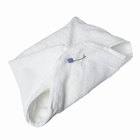Winter months can be trying if you don't have the right garments to keep you warm. Different fabrics offer various levels of protection from factors such as extreme temperatures, moisture and wind. Synthetic fabrics such as polyester and nylon offer characteristics including breathability, durability and moisture wicking. Both materials are shrink-, stretch- and wrinkle-resistant, which makes them staples in active winter wear.
Polyester
Polyester is found in several types of winter wear, from base layers -- the next-to-skin layer of clothing, including shirts and pants -- to mid layers such as long-sleeved shirts. It's the most common fabric used for base layers because it wicks moisture away from the body, and it's breathable and fast-drying. Polyester also is used as a mid-layer because of its moisture-wicking, quick-dry capabilities and because it's inexpensive.
Nylon
Nylon is a synthetic material that is not only lightweight and breathable, but dries quickly and is moisture-wicking. Nylon is more durable than polyester; for this reason, it's often blended with a variety of materials, including polyester, to enhance durability. Nylon reduces the amount of abrasion, which causes pilling and fabric wear, because of its sturdiness.
Insulation and Outwear
Neither nylon nor polyester are insulating, in that they don't offer warmth, nor do they offer a lot of protection against the elements such as wind and rain. Both materials are best worn as an inner layer -- either the base or mid layer. They can be used, however, as part of an insulating layer. The outermost layer/shell of an insulated puffy jacket is often made of polyester and nylon -- warmth is generated from the jacket's inner materials made of faux down, an insulating material.
Related Articles

The Differences Between Fleece & ...

Microfiber vs. Cotton Clothes

How to Keep a Fleece-Lined Jacket From ...

Microfleece Vs. Microplush

The Differences of Neoprene & Thinsulate

The Advantages of Wool Clothing

Winter Clothes Materials

The Advantages of Polyester Cotton

The Difference Between Polartec and ...

Types of Wool Sweaters

How to Soften Leather Jackets

What Is a Thermal Shirt?

What Is the Difference Between Lycra ...

What Is a Textile Motorcycle Jacket?

How to Shrink a Baseball Jersey

How to Windproof a Carhartt Jacket

What Jacket to Wear With Satin Tube ...

Parka vs Bomber Jacket

How to Patch Small Holes in Polar Fleece

Thinsulate Vs. Thermolite
Writer Bio
With 10 years of journalism experience, Alissa Marrapodi is the managing editor of Boardroom Journal and Food Product Design. Covering everything from health and nutrition to beauty and fashion, she holds a bachelor's degree in journalism from the Walter Cronkite School of Journalism and Mass Communication at Arizona State University.